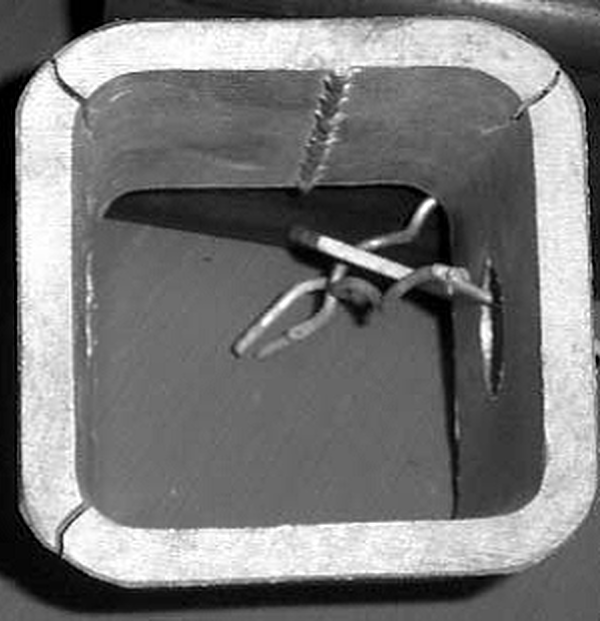Types of Embrittlement & HDG
Hydrogen embrittlement, strain-age embrittlement, liquid-metal embrittlement, galvanizing embrittlement . . . sheesh! I think Im coming down with a case of brain embrittlement trying to determine what form of embrittlement has caused my steel tubes to crack. HELP!
Try not to get too cracked up over embrittlement! Rest assured: you are not alone. The AGA frequently receives questions regarding embrittlement and, often times, the inquirer has mistakenly classified the embrittlement, which then leads them astray in determining the cause of their cracking. Luckily, I have the answers you need to distinguish between the many types of embrittlement and determine the source of your cracking.

The most common misidentification of embrittlement is the over-used (and abused) term, hydrogen embrittlement. The result of steel absorbing hydrogen and retaining it ultimately causes cracking when the steel is put under load. Since this is one of the most widely known types of embrittlement, people will often use this term loosely and, thus, assume all cracking of HDG articles is the result of it. The truth is that there are certain properties and conditions that must exist for hydrogen embrittlement to occur. The property that has the determining effect on whether or not hydrogen embrittlement can occur is the tensile strength of the steel. Steels that have tensile strengths above 150,000 ksi (1100 MPa)* are susceptible to hydrogen embrittlement. The reason being is that higher tensile strength steels consist of a fine-grained structure; the higher the strength of steel, the smaller the grain structure. In steels that have tensile strengths above 150 ksi (1100 MPa)*, the grain structure is so small that some of the absorbed hydrogen (e.g., from chemical cleaning) will remain trapped in between the grains of the steel. Steels with lower tensile strengths have larger grain structures that allow the hydrogen to be expelled when heated to galvanizing temperatures. Without steel above 150 ksi (1100 MPa)*, hydrogen embrittlement is highly improbable. These strengths of steel are typically used for fasteners, anchor rods, or other materials that are going to be subjected to extreme tensile loads. The tensile strength of most steel that is galvanized is often far lower than these types of parts.
*Note: Recent industry research has shown this threshold value is actually 170 ksi (1170 MPa). Be on the lookout for published research from the AGA in the near future.
Now on to the not-so-well-known embrittlements. Strain-age embrittlement refers to cracking caused by previously introduced stresses into the steel and is often the culprit in most embrittlement cases of HDG steel. Steel that has been cold-worked during fabrication develops certain areas of high stress. If these stresses are not relieved by heat treating prior to galvanizing, they can be partially relieved in the galvanizing kettle, which can often cause cracking if the stresses are relatively high. This can be eliminated by two separate methods. First, the steel can be heat treated at 1100°F for one hour per inch of steel section thickness prior to galvanizing, completely relieving the stresses caused by cold working and virtually eliminating the likelihood of cracking after galvanizing. The second method would be to not perform cold working but to hot work the part. By forming fabrications under heat, stresses do not develop in particular areas such as bend corners, punched holes, or other areas that are susceptible to developing high stress. With respect to your particular problem, this is the likely cause of the cracking. The tensile strength of tubes is far below that required for hydrogen embrittlement, as well as the forming operation required to fabricate the tube most likely involved the bending of a flat plate into a tube shape. This operation was probably performed while the steel was cold, and areas of high stress developed at the corners and initiated the cracking of the tube.
Moving right along, next up: liquid-metal embrittlement. This type of embrittlement is the result of molten liquid in contact with solid metal. The liquid metal, under 6 certain conditions (mainly temperature), can penetrate the solid metal and initiate cracking. It is well known that zinc cannot cause the embrittlement of steel due to the fact that people have been galvanizing steel for nearly 150 years. However, other types of metal may be susceptible to this type of embrittlement, but often require much higher temperatures than the temperature of the liquid zinc in the galvanizing kettle. This type of embrittlement is not of concern to hot-dip galvanizers.
Finally galvanizing embrittlement. This is a general term that most people use to classify any type of embrittlement that has occurred on steel that has been galvanized. Since the term is very general, it cannot be defined as any of the three types of embrittlement previously mentioned. Therefore, this term has little meaning and is only the general classification that needs to be defined as one of the previously mentioned forms of embrittlement to be of any use. I hope this solves the mystery of embrittlement and cures your case of brain embrittlement. If it should ever flare up again, read this twice and call me in the morning.
Related Articles
© 2025 American Galvanizers Association. The material provided herein has been developed to provide accurate and authoritative information about after-fabrication hot-dip galvanized steel. This material provides general information only and is not intended as a substitute for competent professional examination and verification as to suitability and applicability. The information provided herein is not intended as a representation or warranty on the part of the AGA. Anyone making use of this information assumes all liability arising from such use.

